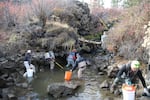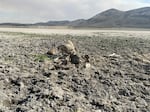Withered crops and puny livestock; dead fish and swarming insects; laid-off workers, shriveling economies, and rural homes stranded without running water — these are just some of the calamities unleashed by a historic drought affecting all of Oregon and parts of Washington.
Oregon lawmakers heard grim updates from state experts in water science, wildlife, emergency management, and public health at the legislature’s Water Committee meeting Wednesday. Farmers shared stories of hardship, while a tribal leader navigating bitter water conflicts wondered what happened to his invitation.
This year’s conditions compounded impacts of a prolonged drought cycle said State Climatologist Larry O’Neill.
“In 16 out of the last 22 years, Oregon has received below-average precipitation statewide,” O’Neill told lawmakers at the informational hearing.
This year, spring and summer precipitation in Oregon neared the lowest ever level recorded in 127 years of data. Meanwhile, high temperatures fueled more evaporation of surface water supplies.
“We had a record number of days above 90 degrees in many places throughout Oregon,” O’Neill said.
In the spring, snowpack melted earlier and faster than usual, leaving less water for streams and rivers over the summer, and prolonging drought conditions into fall.
Over the next three months, the climate forecast is looking up with above-average precipitation expected. This may provide some temporary relief, said state hydrologist Ryan Andrews with the Oregon Water Resources Department.
“But it will be difficult to recover,” he added.

People trap juvenile fish stranded in a side channel of the Deschutes River on Oct. 18, 2021. Without intervention, the fish would be left without water and die as flows are diverted upstream to refill Wickiup Reservoir.
Emily Cureton Cook / OPB
The sustained drought is taking a toll on fish and wildlife, said Chandra Ferrari, Water Program Manager with the Oregon Department of Fish and Wildlife.
“Our fish and wildlife are not having the recovery periods they used to, and so they are having to rebound faster and it’s problematic,” she said.
The stress causes more cold-water fish like salmon and steelhead to die from loss of habitat, disease, parasites, and predators, according to Ferrari.
Water shortages are not limited to streams and rivers. The Oregon Health Authority recorded more than 300 wells going dry across Oregon this year, two-thirds of them in the Klamath Falls area. Lowered aquifers also plagued rural towns relying on groundwater.
“We had 15 public water systems that either had wells go dry, or surface water flows that were too low to supply,” said Andre Ourso, an administrator for the Oregon Health Authority.
In Eastern Oregon, Prairie City had to haul in water by truck, said Morgan Gratz-Weiser, an advisor to Oregon Governor Kate Brown.
The Deputy Natural Resources Policy Advisor said the governor’s office is in the process of drafting a drought relief package for lawmakers to consider. Gratz-Weiser said immediate needs include direct assistance to municipalities and people who use domestic wells. She recommended aid for agricultural producers and irrigators who experienced losses, and funding for spring pesticide treatments to deal with swarming insects.
“A secondary disaster to drought is historical outbreaks of grasshoppers and crickets,” Gratz-Weiser said.

Spring Lake, a private body of water that normally uses water from Upper Klamath Lake, is dry in October 2021.
Holly Dillemuth / JPR News
As of Nov. 9, reservoirs used by irrigation districts had shrunk well below average levels. In the Deschutes basin of Central Oregon, Wickiup reservoir holds less than half the usual amount of irrigation water that is being stored for the next growing season. In Southern Oregon, the Klamath Basin’s Upper Klamath Lake reservoir held just 38% its average amount of water.
Related: Bitter Harvest: Klamath Basin farmers take stock of their losses
Klamath basin farmer Tricia Hill told lawmakers that the crises have stacked up--- with drought, poor air quality, aging infrastructure, and labor shortages.
“We saw a 30 percent increase in wages from last year and we still couldn’t get folks on the ground to help with harvest,” said Hill, who identified herself as a fifth-generation farmer descended from Czechoslovakian settlers.
No Tribal representatives spoke at the hearing, and none appear to have been invited. Greg Mintz, a spokesperson for Water Committee chair Rep. Ken Helm, said in an email that the hearing was “one component of an ongoing focus on these topics.”
“I’m not sure there’s a real active attempt to involve the Tribes,” said Chairman of the Klamath Tribes Don Gentry.
In an interview, he described how this year’s drought hurt sacred fish, and also stirred racist invective over the plight of farmers.
“Confrontations with people, ugly comments, social media posts slamming the Tribes — a lot of it is just marginalizing who we are, and what we stand up for,” Gentry said.
Related: C’waam and Koptu: The fish at the center of the Klamath Basin’s water crisis
The Klamath tribes have fought to protect treaty rights, and ensure the survival of endangered fish species in Upper Klamath Lake. In 1864, the Tribes ceded the title to 22 million acres through a treaty with the U.S., which promised “the exclusive right of taking fish in the streams and lakes.”
This year, water flowing out of the lake was shut off to farmers who rely on the federally managed irrigation system of canals, dams and reservoirs known as the Klamath Project. Even so, there wasn’t enough to meet the minimum needs of fish, Gentry said. He hopes the severity of a situation where everyone loses will catalyze more action.
“I would hope one positive consequence would be that folks would realize the reality of what we’re dealing with, and focus on solutions,” Gentry said.
Correction: A previous version of this story misattributed a statement by Oregon Health Authority Administrator Andre Ourso. OPB regrets the error.

Lost River suckers congregating to spawn on Sucker Springs in Upper Klamath Lake, Oregon.
Brian Hayes / USGS



